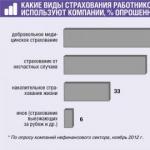
Credit as an effective tool for attracting resources. International credit as a financial instrument Credit as a special financial instrument
The concept "credit" comes from the Latin word "creditum", which means "loan, debt". At the same time, many economists associate it with another, close in meaning term "credo", that is, "I believe", and, accordingly, see in the credit promissory note directly related to the trust of one subject who has transferred a certain value to another.
In economic literature credit, as a rule, it is defined as a system of economic relations arising in the process of providing monetary or other material resources the lender for temporary use to the borrower on terms of repayment, urgency and payment. If the provision of funds is irrevocable and indefinite, then it is called financing.
The forms of credit are closely related to the essence of credit relations. Depending on the loan value, they distinguish commodity, monetary and mixed (commodity-money) form of credit. The commodity form historically preceded the monetary form. In modern practice, the commodity form is not the fundamental, the monetary form of credit is the predominant form. The commodity form is used both when selling goods in installments, and when renting property (including leasing equipment), and renting things.
Depending on who is the creditor in the transaction, highlight the main forms of credit : commercial (economic), banking, consumer, state and international credit.
Commercial (economic) loan Is a loan provided by supplier enterprises to purchasing enterprises by deferring payment for the values sold or by buyers to sellers in the form of an advance or prepayment for the goods supplied. As a result, an economic entity can simultaneously act as a lender and a borrower.
Bank loan – it is a loan provided by banks to their clients in cash. The clients are business and financial structures (legal entities) and citizens (individuals).
Consumer loan Is a loan provided to the population in commodity and cash forms for the purchase of land, real estate, Vehicle, other personal goods. The role of the creditor here is played by both specialized financial and credit organizations and banks, and any legal entities that carry out the sale of goods or services.
State loan- these are monetary funds lent to the state (represented by central and local authorities) to cover its costs, or loans provided by the state itself as a creditor (the second option is less common). The emergence of government spending is associated with the implementation of economic and social programs development of society and the formation of a budget deficit. The population, economic and financial structures act as creditors of the state. The state loan includes the provision by the state of guarantees for loan obligations of legal and individuals.
International credit Is a loan in commodity and cash forms provided to each other by foreign commercial partners and states. Commodity, or intercompany, loans are used in the construction of large national economic facilities. Cash loans are provided by banks, consortia of banks and international financial institutions and are intended for production and stabilization purposes. In modern conditions, the main form of credit is Bank loan.
The role of the loan is revealed in its functions . In the theory of credit, there is no consensus regarding the number and content of the functions of credit. However, in most cases they include:
● redistributive function... Credit operations are associated, first of all, with the accumulation of temporarily free funds of society, the redistribution of which makes it possible to invest free money capital in any sector of the economy. From industries with a low rate of return, capitals are released in cash, and then in the form of credit are sent to industries with a high rate of return. Thus, the loan acts as a mechanism for leveling the rate of return. With the emergence of banks, the processes of redistribution of funds in the economy received the most adequate mechanism;
● function advancing the reproduction process. On the basis of credit, the continuity of the circulation of capital in society and the acceleration of the circulation of capital of each borrower are ensured, which allows him to overcome the time gaps between the need for funds and their surplus without freezing funds in the "liquidity reserves". This function of the loan involves the active use of all forms of credit (commercial, banking, consumer, etc.) and their flexible transformation into each other;
● function creation of credit instruments of circulation ... Since its inception, credit has replaced full-value money with credit instruments - bills of exchange, banknotes and checks. Their use in non-cash settlements, for monetary obligations, significantly reduced cash circulation, and, therefore, distribution costs associated with the manufacture, counting, transportation and storage of cash.
A prominent representative of the capital-creation theory of credit, J. Schumpeter, introduced a provision on innovative essence of credit relations. In his opinion, from a historical and logical point of view, credit is necessary precisely for innovation, it was for them that the companies introduced it into their activities. They needed a loan to create a business, and at the same time its mechanism, having appeared in the process of introducing innovations, affected the old combinations of their work. According to J. Schumpeter, it is this very essence of credit (granting a loan for a project) that is the basis of the modern credit market.
For modern science, it is more typical studying the properties of credit through credit products of credit market participants. In Western and domestic literature and in IFRS loan products are being considered today as financial instruments, i.e., as a relationship based on an agreement between the parties, as a result of which one party (the lender) has a financial asset, and the other party (the borrower) has a financial liability.
At the same time, credit products have both characteristics common to other financial assets and individual properties.
Loan products are a special type of financial assets. Here they are primarily distinguished from other financial assets. recurrent nature placement of funds, which allows us to speak of them as debt products. Loan products are characterized by the movement of value from the lender to the borrower and vice versa.
The recoverable nature of the lent value implies that the lender determines clear terms for its repayment, which, first of all, are expressed in setting the timing of repayment of interim payments and principal debt (which is not the case for shares and other equity instruments) and can be determined as a specific date or the occurrence of certain events. This expresses principle of urgency of lending .
The next principle of lending is chargeable, realized through the interest rate mechanism and representing for lenders the meaning of creating financial assets, a means of preserving the loan value and compensating for their risks, and for borrowers - a cost measure of attracting "other people's" resources, the need for their productive use to achieve the proper return on investment.
In modern conditions, banks provide their clients - non-financial organizations with a variety of types of loans (loan products), which can be classified according to various criteria:
● by groups of borrowers: loans to industry, trade and supply organizations, agriculture, transport enterprises, construction industry, etc .;
● for lending purposes: loans for current needs (serve the needs of companies in working capital) and loans for investment purposes (to finance companies' investments in fixed assets);
● by terms of provision funds:
· Loans on demand;
· Term loans, which are divided into: short-term (up to one year), medium-term (from one year to three years) and long-term loans (more than three years). As a rule, loans that form working capital are short-term, and loans involved in the renewal, expansion, reconstruction of fixed assets are medium-term and long-term;
● to size: large loans (the amount of which exceeds 5% own funds(capital) of banks), medium (from 1 to 5% of banks 'own funds) and small loans (less than 1% of banks' own funds);
● to ensure:
· Unsecured (blank) loans;
Secured loans, which, by the nature of the collateral, are subdivided into: collateralized loans, loans secured by guarantees of third-party solvent and bank guarantees, insured loans;
● by the currency of provision funds: loans in national currency, loans in foreign currency, loans with the borrower's right to choose the currency of the loan (multicurrency loans);
● by methods of granting and repaying loans (lending methods): one-time, term loans, credit lines, overdrafts, syndicated loans;
● in the direction of issue: loans issued to the settlement (current) account of the borrower, and loans issued directly to make payments (payment loans (not permitted by the rules of the Central Bank of the Russian Federation));
● by types of interest rates: loans with a fixed interest rate and loans with a floating interest rate;
● by frequency of repayment: loans repaid in a lump sum (on a specific date, usually at the end of the contract) and repayable in installments (in installments - even or uneven, at the time agreed with the bank);
● by degree of risk: standard loans, non-standard loans, doubtful loans, problem loans and bad loans 1.
The composition of loan products for each bank is determined by the target groups of clients and the specifics of their financial needs, which, first of all, differ in the sphere of servicing current activities and business development. Therefore, the basic types of credit products are short-term (for current needs) and investment products... They should provide an individual approach to borrowers under the banks' standard credit procedures.
Financial instrument is one of the new economic categories market economy. A financial instrument is understood as any contract under which there is a simultaneous increase in the financial assets of one entity and financial liabilities of a debt or equity nature of another entity.
TO financial assets relate:
· cash;
· A contractual right to receive cash or any other type of financial assets from another enterprise;
· A contractual right to exchange financial instruments with another entity on potentially favorable terms;
· Shares of another company.
TO financial commitments contractual obligations include:
· Pay cash or provide some other type of financial assets to another enterprise;
· Exchange financial instruments with another company on potentially unfavorable terms (in particular, such a situation may arise in case of a forced sale of receivables).
As follows from the definition of a financial instrument, there are two types of characteristics that make it possible to qualify a particular transaction as a financial instrument:
1) the transaction must be based on financial assets and liabilities;
2) the operation must be in the form of an agreement (contract).
In particular, inventories, tangible and intangible assets, deferred expenses, received advances, etc. do not fall under the definition of financial assets, and therefore, although their possession could potentially lead to an inflow of cash, the right to receive certain financial assets in the future does not arise. With regard to the second characteristic, for example, the relationship with the state regarding tax arrears cannot be considered as a financial instrument, since this relationship is not of a contractual nature.
Financial instruments are classified into primary , which include loans and borrowings, stocks, bonds, other debt securities, payables and receivables on current transactions, and secondary , or derivatives (sometimes called derivatives in the specialized literature), which include financial options, futures, forward contracts, interest rate swaps, currency swaps.
Most financial instruments represents securities traded on the derivatives market. According to the Civil Code of the Russian Federation (RF) security – this is a document certifying with
observance of the established form and required details property rights, the exercise or transfer of which is possible only upon its presentation ... When a security is transferred to a new owner, all rights certified by it in the aggregate, including those of non-property nature, are automatically transferred to the new owner, if such are implied based on the essence of this security (for example, the voting right inherently associated with ordinary shares).
The main indicators characterizing securities are:
· course ;
· dividends (for shares);
· interest (for other securities);
· profitability ;
· issue volume ;
· volume of transactions ;
· characteristics of transactions (primarily options);
· urgency (for securities with maturity).
Securities have a number of fundamental qualities that distinguish them from other types of documents related to property rights. These qualities are: presentability, circulation and marketability, availability for civil circulation, standardization and seriality, regulation and recognition by the state, liquidity, risk.
One of the types of securities is bond. She belongs to the class debt securities , which also includes bank certificates of deposit and savings, state short-term liabilities, short-term bank bills, treasury bills and notes, bills accepted by the bank, debt certificates, etc. Debt securities are liabilities placed by issuers on stock market for borrowing funds necessary for solving current and future problems.
The bond is the most common form of debt. This is a security that certifies that its owner has deposited funds in the amount specified in the bond, and confirms the obligation to reimburse him for its nominal value within the period provided for therein with payment of a fixed interest, unless otherwise provided by the terms of the issue. Bonds are issued:
· Registered or bearer (coupon);
· Interest or non-interest (target for goods or services);
· Freely circulating or with a limited circle of circulation.
Unlike stocks, bonds of economic entities do not give their owners the right to participate in the management of a joint-stock company, but, nevertheless, are an attractive means of investing temporarily free funds. This is due to the following circumstances:
· Unlike stocks, bonds bring a guaranteed income;
· Bonds belong to the group of easily realizable assets and, if necessary, are converted into cash;
· Payment of interest on bonds of a joint-stock company is made as a matter of priority, i.e. before the accrual of dividends on shares;
· In case of liquidation of the company, bondholders also have a pre-emptive right over shareholders;
investing in government bonds provides certain tax incentives(income on these securities is not taxed, tax on operating
A walkie-talkie with government bonds is charged at a reduced rate, bonds can be used as collateral when obtaining a loan, etc.).
Interest-bearing bond income is paid by paying coupons to bonds. The payment can be carried out periodically or in a lump sum when the loan is repaid by accruing interest to the face value. Coupon - part of the bond certificate, which, when separated from the certificate, gives the owner the right to receive interest (income), the amount and date of receipt of which are indicated on the coupon.
Promissory note - an order security certifying the unconditional obligation of the drawer (promissory note) or another payer specified in the bill of exchange (bill of exchange) to pay at the onset of the term specified in it sum of money to the owner of the bill (bill holder). Like debt pecuniary obligation the bill has a number of features, the most significant of which are as follows:
· abstractness , consisting in the fact that the bill of exchange is not legally tied to a specific contract, i.e. having arisen as a result of a certain transaction, the bill is separated from it and exists as an independent document;
· indisputability , expressed in the fact that the holder of a bill is free from objections that may be put forward by other participants in the bill of exchange agreement or in relation to them;
· right of protest
, consisting in the fact that if the debtor does not pay the bill, the holder of the bill can make a protest, i.e.
on the next day after the expiration of the payment deadline, officially certify the fact of refusal to pay at the notary office at the location of the payer;
· joint responsibility , which consists in the fact that with a timely protest, the holder of a bill has the right to sue all persons associated with the circulation of this bill of exchange, and against each of them separately, without being forced to follow the sequence in which they pledged.
Distinguish between promissory notes and bills. In operation with by promissory note two persons are involved: the drawer, who is obliged to pay the bill, and the drawer, who is entitled to receive payment. Bill of exchange (draft) is written out and signed by the creditor (drawee) and is an order to the debtor (drawee) to pay within the specified time the amount indicated in the bill to a third party - the first holder (remitter). A bill of exchange can be transferred from one holder to another by means of a special transfer inscription - endorsement executed by the endorser on the reverse side of the bill or, if there is not enough space for transfer records, on an additional sheet - allonge ... By means of endorsement, a bill of exchange can circulate among an unlimited number of persons, becoming a means of paying off debt claims.
The list of details that a bill of exchange must contain is strictly regulated by law. The bill contains:
· The name "bill" included in the text of the document and expressed in the language in which this document is drawn up;
· Indication of the due date;
· An indication of the place where the payment is to be made;
· The name of the person to whom or by order of whom the payment should be made;
· Indication of the date and place of drawing up the bill;
· Signature of the person who issued the bill (drawer), etc.
Distinguish between treasury, bank and commercial bills. Treasury bill issued by the government and represents a short-term government obligation with a maturity of three, six or twelve months. Bank bill issued by a bank or a union of banks (issue syndicate). The income of the holder of a bank bill is calculated as the difference between the redemption price, equal to par, and the sale price, carried out on a discount basis. Commercial bill used for lending to trade transactions. In the transaction, as a rule, a bill of exchange is used, and the bank acts as the remitter.
The most popular are bank bills. The main reasons for this are:
· profitability - depending on the term, amount, currency and reliability of the bank, the profitability of its promissory note may vary significantly;
· reliability - in particular, promissory notes issued by groups of large banks, which bear joint responsibility for them, have almost absolute reliability;
· liquidity - almost all issuing banks provide for the possibility early repayment... Bills of exchange can be used as payment by drawing up an endorsement on the bill;
· collateral value - a bill of exchange can be used as a savings instrument and as a pledge. Some exchanges accept bank promissory notes as payment to guarantee the execution of futures contracts.
Receipt – represents money document in the form established by law, containing an order from the owner of the account who wrote the check on the payment of the amount of money indicated in it to the owner of the check. Organization of settlement transactions using checks involves the interaction of at least three parties: the drawer, i.e. the person who wrote the check, the check holder, i.e. the person who accepted the check as payment for the goods, work or services provided, and the payer of the check, i.e. the bank in which the drawer's account is opened. The check serves as the most important means of payment, which expresses the unilateral obligation of the drawer to pay the check if the payer refused to pay. When calculating by checks, the account holder - the drawer - gives an unconditional written order to the bank that issued the check to make the payment of the specified amount to the check holder or by his order. The obligation to pay the check is determined by the agreement between the drawer and the paying bank.
Certificate of Deposit - written evidence credit institution(issuing bank) on the deposit of funds, certifying the owner's right to receive the deposit amount and interest on it after a specified period.
Certificates of deposit are mainly intended for business entities. The attractiveness of the certificate is that it can be transferred from one owner to another, and its price at the time of transfer depends on the capacity secondary market, the maturity date of the certificate and the current interest rate on financial instruments of the same class.
Savings bank certificate - has the same mechanism of action as a certificate of deposit, but is intended for individuals. The certificate can be issued for a specified period or on demand. In the event of an early return of funds on an urgent certificate, at the initiative of its owner, a reduced percentage is paid, the amount of which is indicated in the agreement concluded when the money is deposited for storage.
Bill of lading - is a document of title, with the help of which the sea transportation of goods is registered. List of mandatory
details and conditions for drawing up this document are defined in the Merchant Shipping Code of the Russian Federation. The bill of lading is issued by the carrier to the sender after receiving the goods and confirms the fact of the conclusion of a contract between them. As a security, a bill of lading can be registered (the name of a specific consignee of the cargo is indicated), order (the cargo is issued by the order of the sender, consignee or bank), to the bearer (any person who presented this document can be the consignee).
Promotions - equity securities confirming the right of their owner to participate in the management of the company (usually, with the exception of preferred shares), in the distribution of the company's profits and in obtaining a share of the property proportional to its contribution to authorized capital, in the event of the liquidation of this company.
One of the most important conditions for the functioning of the capital market is information on securities. Distinguish information the following types:
· Statistical (market value, volume of transactions, amount of dividends, profitability, etc.);
· Analytical (analytical reviews and assessments, recommendations to investors, judicial precedents, etc.);
Regulatory (legislative and regulations regulating the issue and circulation of securities).
A bank loan is one of the most common forms of credit relations in the economy, the object of which is the process of transferring funds into a loan on terms of urgency, repayment, and payment.
A bank loan expresses the economic relations between creditors (banks) and lending entities (borrowers), which can be both legal entities and individuals. The bank form of credit is the most common form, since it is banks that most often provide loans to entities in need of temporary financial assistance.
A bank loan is provided exclusively by credit and financial institutions licensed to carry out such operations.
The main principles of lending, including banking, which must be observed in the process of issuing and repaying loans, are:
the urgency of the return;
target character;
chargeable;
security;
differentiation;
Repayment is the feature that distinguishes credit as an economic category from other economic categories of commodity-money relations. Credit cannot exist without repayment. Repayment is an integral feature of the loan, its attribute.
The urgency of lending is a necessary form of achieving loan repayment. The principle of urgency means that the loan should not only be repaid, but repaid within a strictly defined period, i.e. in it the time factor finds concrete expression. And, therefore, urgency is a temporary definiteness of loan repayment. In market conditions of management, this principle of lending is given, more than ever, special importance:
1. Normal provision depends on its observance social reproduction cash, and, accordingly, its volumes, growth rates.
2. Compliance with this principle is necessary to ensure the liquidity of the commercial banks themselves. The principles of organizing their work do not allow them to invest the attracted credit resources into irrecoverable investments.
3. For each individual borrower, compliance with the principle of the urgency of loan repayment opens up the possibility of obtaining new loans at the bank, and also allows you to comply with your self-supporting interests without paying increased interest for overdue loans.
The targeted nature of the loan involves the issuance of loans for strictly defined purposes, which, like objects, can vary widely. Everyone potential borrower when applying for a loan, be sure to indicate a specific purpose. The bank, having issued a loan, is called upon to check its intended use, in cases of violation of the conditions loan agreement must apply sanctions.
The principle of repayment of a loan means that each borrowing company must pay the bank a certain fee for temporarily borrowing funds from it for its own needs. The implementation of this principle in practice is carried out through the mechanism of bank interest. The bank interest rate is a kind of "price" of the loan. The bank can pay for a loan to cover its costs associated with the payment of interest on other people's funds attracted in deposits, the costs of maintaining its own apparatus, and also provides a profit to increase the resource crediting funds (reserve, statutory) and use for own and other needs.
The main factors that modern commercial banks take into account when setting loan fees:
Base interest rate on loans to commercial banks of the Central Bank of the Russian Federation;
Average interest rate on an interbank loan, i.e. for resources purchased from other commercial banks for their active operations;
Average interest rate paid by the bank to its customers on various types of deposit accounts;
The structure of the bank's credit resources (the higher the share of borrowed funds, the more expensive the loan should be);
Demand for credit from business executives (the lower the demand, the cheaper the loan);
The period for which the loan is requested, and the type of loan, or rather the degree of its risk for the bank, depending on the collateral;
Stability of monetary circulation in the country (the higher the inflation rate, the more expensive the loan payment should be, since the bank increases the risk of losing its resources due to the depreciation of money).
Under the conditions of a planned economy, the principle of credit security was interpreted by our economists very narrowly: only the material security of the credit was recognized. This meant that loans had to be issued against specific material values that were at different stages of the reproduction process, the presence of which throughout the entire period of use of the loan testified to the security of the loan and, therefore, the reality of its return. Only with the adoption at the end of 1990. Of the Law "On Banks and banking»Commercial banks of the Russian Federation were able to issue loans against various forms of loan security, adopted in international banking practice, and subsequently enshrined in the Civil Code of the Russian Federation. This is a pledge obligation, a guarantee agreement, a surety agreement, etc. Security of obligations for bank loans in one or several forms at the same time is provided by both parties to the credit transaction in the credit agreement concluded between themselves.
Differentiated lending means that commercial banks do not have to unambiguously approach the issue of granting loans to their clients applying for it. The loan should be provided only to those economic agencies that are able to repay it in a timely manner. Differentiation of lending should be carried out on the basis of indicators of creditworthiness - the financial condition of the enterprise. These qualities are assessed by analyzing the balance sheet for liquidity, the provision of the farm with its own sources, the level of its profitability at the current moment and in the future.
The cumulative application of all principles in practice bank lending allows you to comply with both national interests and the interests of both subjects of the credit transaction: the bank and the borrower.
Credit conditions are as follows:
coincidence of interests of both parties to the credit transaction;
the availability of both the creditor bank and the borrower of the ability to fulfill their obligations;
the possibility of implementing the pledge and the availability of guarantees;
ensuring the commercial interests of the bank;
conclusion of a loan agreement.
A bank loan is classified according to a number of characteristics:
I. By main groups of borrowers:
Loan to the farm;
The population;
Government authorities.
II. By terms of use:
Poste restante;
Urgent:
Short-term (up to 1 year),
Medium-term (from 1 to 3 years),
Long-term (over 3 years).
Based on the characteristics of the market economy of Russia, it is necessary to consider also another classification of term loans: short-term (up to 1 year) and long-term (more than 1 year).
Short-term loans are provided to fill a temporary shortage of the borrower's own circulating assets. A short-term loan serves the sphere of circulation. The most actively used are short-term loans in the stock market, in trade and services, in the interbank lending regime.
Medium-term loans are provided for production and commercial purposes. The most widespread are in the agricultural sector, as well as in lending to innovative processes with average volumes of required investments.
Long-term loans are used in investment purposes... They serve the movement of fixed assets, differing in large volumes of transferred credit resources. They are used for crediting reconstruction, technical re-equipment, new construction at enterprises of all spheres of activity. Long-term loans received special development in capital construction, fuel and energy complex.
III. By appointment (direction):
Consumer;
Industrial;
Trade;
Agricultural;
Investment;
Budgetary.
IV. By repayment methods:
Loans repaid in installments (in parts, shares);
Loans repayable in a lump sum (for one specific date).
Loans repaid in installments during the entire term of the loan agreement. The specific conditions for the return are determined by the contract. Always used for long-term loans.
Loans repaid by a lump sum from the borrower. This traditional form of repayment of short-term loans is optimal, because does not require the use of the differential interest mechanism.
V. Depending on the area of operation:
Loans participating in the extended reproduction of fixed assets;
Credits participating in the organization of working capital (credits directed to the sphere of production, and credits serving the sphere of circulation).
Vi. By issuing method:
Compensatory - the loan is sent to the current account of the borrower to reimburse the latter for his own funds invested either in inventory items or in costs.
Payment - the loan is sent directly to the payment of settlement documents presented to the borrower for payment for the activities being credited.
Vii. By lending methods:
One-time loans provided on time and in the amount stipulated in the agreement concluded by the parties.
A credit line is a legal obligation of the bank to the borrower to provide him with loans within a certain period of time within the agreed limit.
Credit lines are:
Renewable is a firm commitment by the bank to issue a loan to a client who is experiencing a temporary shortage of working capital. The borrower, having repaid part of the loan, can expect to receive a new loan within set limit and the term of the contract.
A seasonal credit line is provided by the bank if the company periodically has a need for working capital associated with seasonal cycles or the need to build up stocks in a warehouse.
Overdraft is short-term loan, which is provided by debiting funds from the client's account in excess of the balance on the account. This results in a debit balance on the customer's account. Overdraft is a negative balance on the client's current account. Overdraft may be permitted, i.e. preliminarily agreed with the bank and unauthorized, when a client writes a check or a payment document without the bank's permission to do so. Overdraft interest is charged daily on the outstanding balance and the client pays only for the amounts actually used.
VIII. By types of interest rates:
Loans with a fixed interest rate, which is established for the entire crediting period and is not subject to revision. In this case, the borrower undertakes to pay interest at the unchanged agreed rate for using the loan, regardless of changes in the market interest rates. Fixed interest rates are applied for short-term lending.
Loans with floating interest rates. Floating rates are those that are constantly changing depending on the situation in the credit and financial markets.
Graduated interest rate loans. These interest rates are reviewed periodically. Used in times of strong inflation.
IX. By types of borrowers:
Loans legal entities;
Loans to individuals
By size: large, medium and small.
XI. By availability of collateral:
Unsecured (blank) loans;
Secured, which, by the nature of the security, are also subdivided into pledged, guaranteed and insured.
Trust loans, the only form of security for the return of which is a loan agreement. This type of loan does not have specific security and therefore is provided, as a rule, to first-class creditworthy customers with whom the bank has long-standing ties and has no claims for previously issued loans.
Pledge agreement. Pledge of property (movable and immovable) means that the pledgee creditor is entitled to sell this property if the obligation secured by the pledge is not fulfilled. The pledge must ensure not only the return of the loan, but also the payment of the corresponding interest and penalties under the contract, provided for in the event of its failure.
Guarantee agreement. Under this agreement, the guarantor is obliged to the creditor of another person (borrower, debtor) to be responsible for the latter's fulfillment of his obligation. The borrower and the guarantor are liable to the creditor as joint and several debtors .
Guarantee. This is a special type of surety agreement to secure an obligation between legal entities. Any financially stable legal entity can be a guarantor.
Credit risk insurance. The borrowing company enters into an insurance contract with the insurance company, which provides that in case of non-repayment of the loan within the specified period, the insurer pays the bank that issued the loan, compensation in the amount of 50 to 90% of the loan amount not repaid by the borrower, including interest on the use of the loan.
XII. According to the degree of risk:
Standard;
Non-standard;
Doubtful;
Hopeless.
XIII. By the purpose of the loan:
General loans , used by the borrower at its discretion to meet any need for financial resources. In modern conditions, they have limited use in the field of short-term lending, with medium- and long-term lending, they are practically not used.
Target loans, implying the need for the borrower to use the resources allocated by the bank solely for solving the problems determined by the terms of the loan agreement (for example, payment for purchased goods, payment of salaries to staff, capital development, etc.). Violation of these obligations entails the application to the borrower of the sanctions established by the agreement in the form of early withdrawal of the loan or an increase in the interest rate.
The need and the possibility of attracting a bank loan is due to the regularities of the circulation and turnover of capital in the process of reproduction: in some places temporarily free funds are released, which act as a source of credit, in others there is a need for a loan, for example, to expand production. Thus, credit contributes to economic growth: the lender receives payment for the loan, and the borrower increases his production assets and renews them.
The methodology for calculating the need to attract a bank loan to finance the current costs of an enterprise is a logical procedure for assessing the feasibility of using a bank loan as an instrument of external financing.
The calculation of the need for a bank loan is based on the following basic conditions. First, the possibility of attracting credit resources is considered as one of the alternatives to bridge the time gap between the inflow and outflow of funds. The decision to attract a loan is made subject to the greater economic feasibility of this method of external financing, in comparison with other available methods of covering the cash gap. Second, the enterprise planning system must support the simulation function. To select the optimal source of funding, it is important to be able to carry out a preliminary assessment of the consequences of making various decisions - in this case when using certain methods of covering the cash gap.
The information necessary to solve the problem of identifying the fact of a cash deficit, its value, is reflected in the cash flow statement. Cash flow statement is a financial document that presents, in a systematic form, at a given time interval, the expected and actual values of the inflows and outflows of the enterprise's funds. The cash flow statement shows the projected values of the cash balance for a specific date and signals the planned need for additional resources. The data used as input in the cash flow statement is generated by the output of operating budgets. Operating budgets are estimates of planned and actual values of receipts and outflows of funds, grouped by the basis of the enterprise's operations of the same type.
After identifying the size of the cash deficit, the date of its formation and the period of operation, it is necessary to take measures to eliminate it. First of all, the reason for the deficit is found out; the first option to cover the deficit may be to eliminate its cause.
The main task of the management of any company - effective management of the limited resources at its disposal - in relation to cash management in the short term is solved by manipulating a number of parameters that determine the duration of the financial cycle. Let us recall that the financial cycle for an enterprise is a period of time that starts from the moment of delivery of raw materials, materials and components or the receipt by suppliers of an advance payment for their delivery and ends with the moment the enterprise receives payment for products shipped to customers. With competent management of the financial cycle, it is possible to significantly affect the company's needs for working capital and the speed of their turnover, which will not only affect the efficiency of the business, but also the company's needs for working capital.
What are the possibilities for this?
The funds so necessary for the enterprise can be released, in particular, by changing the duration, resource intensity and other parameters of the production cycle (i.e., the method or technology for carrying out core activities). At the same time, it is clear that, for example, in the case of considering the feasibility of changing technology, additional investments cannot be dispensed with and the analysis of the consequences of such decisions should be carried out as carefully as possible.
In addition to such drastic transformations as replacing equipment, changing technology, reengineering an enterprise affecting the very foundations of its activities, it is possible to use less radical means, in particular, the deployment of broad industrial cooperation (i.e., purchasing part of the components instead of producing them independently) ...
You can also increase your cash flow by increasing your sales. However, when making attempts to "play" with the price of production, one should at least analyze the break-even of production.
Consideration of the possibilities of accelerating inventory (or, more broadly, resources) turnover should not be left aside. Their presence, obviously, is determined by the company's desire to reduce the risk of more serious losses that may arise as a result of the interruption of core activities, the emergence of unsatisfied demand, etc., than from incurring additional costs, the level of which is determined by the volume of these reserves. At the same time, considering this issue, the term "stocks" should be understood rather broadly: we can talk about stocks of final products, semi-finished products and raw materials, natural and labor resources as well as cash reserves.
What should be the volume of stocks? As long as the potential losses exceed the costs of maintaining stocks, the availability of certain volumes of them seems to be beneficial, but the final decision should be made only after a detailed analysis of all possible options. At the same time, practice shows that in the process of a careful study of the reasons for the emergence of certain reserves, it may turn out that they can be dispensed with at all or, at least, their volumes can be reduced.
A company can also influence the duration of the financial cycle and the efficiency of its operations by using certain means of payment and schemes for settlements with suppliers, consumers, etc. At the same time, its relationships are important not only with other participants in the value chain, but also with banks, since at the same time it is possible to choose certain financial instruments and optimize their parameters (percentages, speed of payment, etc.). Accordingly, the correct choice of these tools can be carried out only after comprehensive calculations and comparison of various schemes of their use. The choice of a specific method to cover the cash deficit is carried out in two stages. At the first stage, from the available alternatives, methods are selected, the expediency of which is confirmed by calculations of a strategic nature. For example, a request to counterparties to speed up settlements can reduce the level of confidence in the enterprise, so it is impractical to use them. The second stage analyzes the consequences of using each of the options. The selection criterion is financial condition enterprise caused by the use of a specific method of covering the deficit.
14.3. Credit as a tool for socializing financial relations
The term "credit" (kredo) originally comes from the Latin language and literally translates - "believe". Credit means various economic processes. In the early stages of the development of commodity-money relations, a transaction as a sale and purchase with a deferred payment was represented by a loan. The loan was known for several millennia BC. He had a natural and monetary form... These forms developed both in parallel and subsequently diverging gradually in terms of the level of meaning and scale of manifestation. Credit acquires more developed forms and content under capitalism. At the present stage of the functioning of the market and mixed economy it is unthinkable to consider a loan without loan capital or fund and interest.
Loan capital (fund) is an economic relationship of the formation of funds, which are intended for use by the borrower for a certain period and for a fee in the form of interest. One of the forms of manifestation of loan capital is credit. The potential content of this form includes the second part of the definition of loan capital, which expresses the possibility of the manifestation of relations on the borrower's use of the lender's funds for a certain period for a fee in the form of interest. Therefore, credit, as an economic category, completely depends on the initial conditions for the existence of loan capital.
Historically, loan capital was preceded by usury, which was widespread in slave and feudal society. The usurers also provided money not to rich people so that they would not pay off old debts, but to buy their goods at inflated prices; the ruling nobility - for the construction of palaces, the purchase of luxury goods, payment of cards and other debts at high interest rates.
Usury hindered the formation and development of the capitalist economy, but the nascent new class of capitalist entrepreneurs waged a stubborn struggle to reduce interest on loans. Entrepreneurs are in need of borrowed capital (credit) in the development of natural resources, the construction of economic facilities, the modernization of existing production facilities, the accumulation of production resources of seasonal importance, and the purchase of raw materials. Under capitalism, large-scale machine production determines a high capital intensity, so entrepreneurs do not have enough own funds. The trend towards a significant increase is especially noticeable now. borrowed money for investments in Japan, Italy, France. Japanese firms use borrowed resources to finance up to 4/5 of all funds to expand production. Capitalist production predetermines, on the one hand, the demand for monetary resources, and on the other hand, their supply. In the process of the circulation of industrial capital, business entities have temporarily free funds: part of the proceeds from the sale finished products; funds from the fixed capital depreciation fund; part of the profit going to accumulation and personal income ...
The market for loan capital arose under the conditions of the capitalist mode of production. The subject of sale and purchase in the investment market is money capital. Money acquires an additional property - the ability to generate profit. Two persons are involved in this transaction: the owner-creditor of inactive (free) capital and a businessman-borrower who wants to put this capital into circulation to make a profit. Here the right to use free money resources is sold for a certain time and for a certain fee. In modern conditions, the main sources of loan capital are the funds released in the process of reproduction. These include:
Depreciation fund of economic entities intended for renovation, expansion and restoration of production assets;
Part of the working capital released in the process of selling products and making material costs;
Cash generated as a result of the gap between the receipt of money from the sale of goods and the payment of wages;
Profit spent on renovation and expansion of production;
Cash income and savings of all segments of the population;
State money savings in the form of funds from property ownership, income from production, commercial and financial activities of the government, as well as a surplus of central and local banks.
These sources of free funds and the need for them on the part of business become a necessary condition for the development of credit. It is one of the forms of manifestation and functioning of loan capital. Credit also serves as a tool in the system of financial relations aimed at expanding social production, economic growth and socialization of market economy. The loan allows you to purchase housing, a car, TV, communication and communication facilities, a computer, household appliances, improve living conditions and increase the well-being of citizens. It can be noted here that in highly developed countries, credit covers the bulk of the population. On the one hand, citizens are borrowers when they buy goods on credit, but on the other, they become lenders when they save their own money and open a deposit account with a bank. Over the past decades (20–30), the use of savings of the population has become predominantly active as a source of loan capital and credit. This trend is inherent in England, Germany, France, Italy, Canada, USA, Japan, South Korea and other countries. Usually, the population's savings are kept in banks, pension funds, insurance companies, financial institutions and as securities. Credit is a part of financial relations (system). Therefore, it will not be correct to single out the concept as "financial and credit relations (system)", although it is found in various economic publications. The totality of credit relations with the subjects of its implementation constitutes the structure of the credit system. The functioning structure of credit relations is the credit system, which serves as a subsystem of finance. The modern credit system is a functioning set of credit relations of various institutions that accumulate monetary resources and operate in the loan capital market. The functioning of the credit system implements the essence and functions of credit.
The loan performs the following functions:
Reducing transaction costs;
Accumulation and mobilization of funds;
Redistribution of monetary resources;
Saving costs of production, circulation, reproduction;
Acceleration of concentration and centralization of capital;
Assistance in the regulation and social orientation of the market economy.
These functions and the essence of the loan are implemented on the basis of the principles of lending, which interconnect the content of the credit mechanism.
The principles of lending include:
1. Purposeful nature of the loan. It means that the lender will not issue a loan if he does not know the goals of the borrower, what he intends to spend this money on. The lender must verify the reality of the calculation and the client's expectations.
2. Repayment of the loan. This principle follows from property relations, where the lender, as the owner of the loan capital, has the full right to reimburse it, which is guaranteed by the material or financial security of the borrower.
3. Urgency of the loan. This principle follows from the previous one, since the borrower must repay the loan. The term of the loan depends on the purpose of the borrower: renovation of fixed assets or an increase in the working capital, the cost of new construction.
4. Payability of the loan. Property relations in the system of a market economy determine the payment by the borrower in the form of a court interest for the provided service of using the creditor's ship capital.
Further, the fifth principle "material security of the loan" is proposed. However, this principle seems to be a constituent element of the content of "loan repayment", since it is not feasible without the client's material security ... Credit has two main forms of implementation: commercial and banking. These forms differ from each other in the composition of the participants, the object of loans, the amount of interest and the scope of their functioning. A commercial loan expresses a relationship for the provision of a service in the form of the sale of goods with deferred payment by some functioning firms to others. Economic instrument such a loan is a bill of exchange to be paid through a commercial bank. Traditionally, the object of a commercial loan is a commodity that serves the circulation of industrial capital, the movement of products from the sphere of production to the sphere of commodity circulation and consumption. Here the peculiarity of commercial credit is that the loan capital in this case merges with the industrial one. The main purpose of a commercial loan is to accelerate the sale of goods and the profits contained in them. The interest on this form of loan is usually lower than on a bank loan.
The instrument for the implementation of a commercial credit transaction is a bill of exchange, which is a kind of securities. A bill of exchange is a document, a written promissory note that gives its owner the right to receive a specified number of monetary units in it after a certain period. There are basically two types of promissory notes: simple and transferable. A promissory note is an obligation of the entity that issued it for payment of a certain amount to the owner of this document within a specified period. A bill of exchange (draft) is a written order from the holder of the bill (drawer) to the payer (drawee) to pay the amount of money indicated in this document to a third party (acceptor) who undertakes to pay the bill. These types of documents represent the elements of the credit mechanism that serve the implementation of property relations and the function of credit ...
Bank loans are provided by banks and other financial institutions to legal entities (industrial, transport, trading companies, firms and organizations in the service sector), the population, the state, foreign clients in the form of cash loans. A bank loan differs from a commercial one in that it exceeds the boundaries of the latter in direction, terms, sizes and has a wider scope of application. Bank credit is more elastic, growth dynamics prevails and security is increasing. The volume of a commercial loan depends on the cyclical development of production and commodity circulation. A bank loan is determined by the state of debts in various sectors of the national economy. At the same time, this type of loan is also due to cyclical fluctuations in macroeconomics.
The bulk of the loan is carried out through banks, which have their own two-tier structure and are divided into central and commercial banks. Banks' resources include their own, issued and borrowed funds. Fixed funds of banks are attracted in the form of deposits (deposits), correspondent and checking accounts. Another insignificant part of the resources of modern banks are their own funds.
central bank has the right and performs the following functions:
Issuing money;
Organization of money circulation and credit;
Storage of state gold and foreign exchange reserves;
Keeping the reserve fund of commercial banks and other credit institutions;
Stabilization of monetary units;
Control over the activities of commercial banks;
Monetary regulation of the national economy.
For efficient functioning The Central Bank in highly developed countries there are mechanisms that do not give the government the right to freely dispose of the resources of the bank in financing budget expenditures. However, the Central Bank must be under the control of parliament and work for the good of the country. Commercial banks belong to the second tier. They provide services to legal entities and individuals in credit and settlement transactions.
Currently, there are several forms of bank loans:
Consumer loan. It is provided by banks, specialized financial institutions, trading companies to the population for the purchase of goods and services with payment by installments. This kind of loan allows you to sell durable goods (cars, furniture, household appliances and others).
Mortgage. This type of loan is issued for the purchase or construction of housing, purchase of land. The mortgage loan has especially high level development in the USA, Canada, England.
State loan. It must be divided into proper government credit and public debt. In the first case, the financial institutions of the state provide loans to various sectors of the economy. In the second case, it borrows money from banks and other financial institutions in the capital market to finance government budget deficits and debt.
International credit. This type of loan is of both private and public nature. It reflects the movement of loan capital in interstate economic relations.
Usurious loan. It still persists in a number of developing countries where the credit system is poorly developed. In general, such a loan is provided by individuals or exchange offices, as well as some banks. This kind the loan is characterized by extremely high interest rates.
The modern credit system of highly developed countries over the past decades (40-50) has undergone qualitative structural changes. The role of financial institutions such as insurance, investment companies, pension funds, etc. has increased. This was facilitated by a decrease in the influence of banks in the development of credit relations. This process is characterized by an increase in the total number of new financial institutions and an increase in their share in the total assets of all credit and financial institutions. This trend in the evolution of the credit system is beginning to be observed in many developing countries.
The features of the development of the modern credit system of highly developed countries include:
concentration and centralization of banking capital;
increased competition between various subjects of the implementation of credit relations;
continuation of the merger of large credit and other financial institutions with industrial, transport, trading companies;
accelerating the internationalization of the activities of credit and financial institutions.
In modern conditions, thanks to the loan, there is a huge concentration of investment in key, progressive sectors of the economy. Only large banks and financial companies can carry out lending operations to meet the needs money capital industrial, transport, trade and other corporations. Credit plays an important role in resolving the problems of selling goods and services. During the formation of a market economy for the development of small and medium-sized businesses, it makes sense to lend to entrepreneurs - manufacturers with public resources to a greater extent at the level of international interest rates, and, if necessary, oblige private banks, within 40-60% of their financial resources, to provide loans at preferential rates for the development of entrepreneurial activity on the basis of a full or partial state guarantee.
The large growth in consumer and mortgage lending to the population expanded the market for consumer durables and played a significant role in the formation and development of the social orientation of the market economy. This stage of highly developed countries is characterized by a more complete delineation of functions between financial institutions within the credit system. Its structure is changing sharply, where the most important positions begin to take Insurance companies, in particular life insurance companies, retirement and investment funds, and other specialized companies. They are becoming the main source of long-term investment, pushing commercial banks out of the loan capital market. At the same time, such a change in the share of commercial banks does not diminish their role in national economy... Banking institutions continue to perform the main functions of the credit system, in particular, settlement operations, deposit and check issue, short and medium term, and a certain share of long-term financing.
The formation of international conditions for reproduction is largely influenced by the development of credit relations, and the activities of banks at the world level. They contributed to the development of international economic relations. In the 19th century, the credit system in England was the most developed and ramified. At the same time, the USA, EU countries, Japan are the leaders. Many developing countries seek to adopt the organizational forms and methods of credit and financial institutions of highly developed countries, in particular, insurance and investment companies, pension funds, consumer credit institutions. However, the world economic crisis the beginning of the XXI century showed many flaws in Western financial systems. Therefore, international economic experts are looking for ways to radically change the functioning of the financial system for the benefit of the progressive development of the world economy. Seeing the positive results of the Islamic economy, the experience of China, they deliberately began to pay attention to the development of the economies of the countries of the East.
Of particular note is the credit system built on the principles of Islamic banks. It is distinguished by sustainable development, alternative principles of lending based on Sharia law from the holy book "Koran", which predetermine not only the ordinary life of Muslims, but economic, commercial and financial activities. The Qur'an says: “Those who are greedy for gain (percent - amendment by KS), will be resurrected as those who were maddened by Satan by his touch will be resurrected. It will be to them for what they say: "more than the same as profit in trade." But God allowed profit in trade, but forbade excess. The one to whom this instruction comes, and he will be abstinent, that will be for that condescension: his activity before God. And those who turn to the former - they will be sufferers in the fire, they will remain in it forever. God removes excess from use ... God does not love a single wicked person, not a single lawbreaker. " A. Jabiev, - explains: “... Islam cares about global justice: it is believed that if one party sells money to the other without risk participation, without partnership, it receives some benefit regardless of the result of this transaction, that is, there is an element of exploitation, there is an element of injustice. That is, it is necessary to earn money by creating it through labor, and not to receive interest. …Exist general principles, which no one disputes, therefore there are a number of operations that are the same for all Islamic banks. " Banks operating on Islamic principles do not have a source of profit from the difference between the interest on loans issued and the interest on borrowed funds. But they also have three sources of profit, like "musharaka", "mudaraba" and "kard ul hasan".
Musharaka - it is cooperation, when the parties combine their capitals to finance the project, dividing the profit on the contribution of each participant and the losses in a predetermined order.
Mudarabah is an agreement between two parties, where one party provides financial resources for the project, and another (known as mudarib) takes over the management of the project.
Kard ul Hasan- a charitable loan provided as material aid needy individuals, organizations, short-term subsidies for specific activities of the firm, which is often a partner of the bank.
The mechanism for determining profits by Islamic banks is more stable, stable and fair compared to the Western approach. It is more objective in determining the degree of participation of each partner in the implementation of the planned project. Western banking does not control the use of capital. And Islamic banks are engaged in the purchase and sale of goods, here money performs the main function - a measure of value.
In modern conditions of the development of the global financial system, "Western banks, such as Citibank and Societe Generale, are already providing services to clients in accordance with the principles of Islamic laws. And in the near future, banks operating according to Islamic principles may well appear in Russia, ”sums up A. Dzhabiev.
Thus, credit relations, being a form of movement of loan capital, contribute to the development of the national and world economy, the expansion of its scale and serves as one of the economic instruments affecting the welfare of citizens and the socialization of the market economy, provided that they are aimed at the implementation of programs for the harmonization of individual and social , state interests.
Concepts and terms
Credit; loan capital; loan interest; commercial loan; Bank loan; bill of exchange; deposit; consumer credit; mortgage.
Issues addressed
1. Socio-economic nature of the origin and development of credit.
2. The mechanism of functioning of credit relations.
3. Types of credit in modern conditions.
Questions for seminars
1. Subjects of the credit system.
2. Principles of lending.
3. Features of the development of the modern credit system of highly developed countries.
Exercises
Answer the questions and define the type of problem (scientific or educational), substantiate your point of view, identify the system of problems on the topic.
1. What problems are typical for the credit system?
2. What is the difference between bank and commercial loans?
3. Why is a usurious loan an anachronism?
Topics for essays
1. Credit for increasing the efficiency of social reproduction.
2. Bank loan in the development of entrepreneurship.
3. Development of mortgage lending to improve the living conditions of the population.
Literature
1. Economic theory. Textbook / Ed. A.I. Dobrynina, L.S. Tarasevich. - SPb, 1999: ill.
2. P.G. Ermishin. Fundamentals of Economic Theory.-Tavri, 1994 ().
3. Litovskikh A.M., Shevchenko I.K. Finance, money circulation and credit / Uch. pos. - Taganrog, 2002. (http: //www..htm).
4. Shishkin A.F. Economic theory / Uch. pos. 2nd ed. Book 1.-M., 1996: ill.
5. Balikoev V.Z. General economic theory... - M., Novosibirsk, 2005.
6. Koran / Per. with arab. lang. G. S. Sablukova. - Kazan, 1907.
7.www. creditos.ru/user/oksana.(2007)
| Previous |
When is the loan justified? Are there situations when the use of credit funds is beneficial? According to bank advertisements, loans are always for the good of mankind. But we are adults. Let's try to deduce some situations when a loan is acceptable using the example of https://turbomoney.kz/, while excluding all kinds of unbridled "Wishlist". The common features of such loans will be the impossibility to pay for something in the required timeframe from the savings and the absolute need to acquire this "something".
Home purchase loan
This is an extremely common and, most importantly, a fairly reasonable loan. To buy housing in modern conditions, except on credit, for the majority of our compatriots can not afford. But it is a mortgage loan that can save many people from problems, both family, organizational, and purely psychological. Moreover, investing money in real estate is profitable, since over the past two decades, housing has been constantly increasing in price, at a rate that significantly outstrips inflation.

Credit for treatment
The need to use borrowed funds to treat oneself or a loved one is not an uncommon need. It is advisable, of course, to acquire insurance and some kind of reserves in advance, but what to do if they are not enough or simply not there for some reason? Here we already have to take such a serious step as a loan.

Credit to pay for education
Our knowledge is our only real asset that is not subject to inflation. Although modern education has a highly controversial effectiveness, a good formal education is not superfluous. It is very difficult to measure the benefits of this action in monetary terms. Therefore, in the case of using credit funds when paying for tuition, you should think carefully about everything and how to calculate it. What education will give you, will you be able to earn more with it, how much, including interest on the loan, this education will cost you, how long will it take to pay off the loan, etc. You cannot make such decisions spontaneously, otherwise you risk wasting money and time in vain.

Loan for savings
Oddly enough, but this is also quite real. How can you save something with a loan if we pay credit institution pretty decent money on top of what they took ?! This is possible, for example, if we purchase something with the help of which we can reduce our expenses or increase income. It can be some kind of water and light meters (count carefully - our housing and communal services are happy to make those purchasing meters pay more than others) or some tool with which your work will become more efficient, and, accordingly, earnings will increase. It is possible to save money by purchasing some goods on credit at wholesale prices in large quantities, which you and your family will use for several years.

Credit is not always evil
In many situations, a loan is a tool with which a reasonable person can solve his problems much more efficiently and with less losses, or, on the contrary, make some kind of breakthrough in welfare.

















